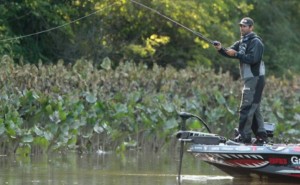
I use Berkley Trilene 100% Fluorocarbon line about 70 percent of the time. I only use monofilament with some top water lures — those that need a floating line to perform properly — and braid for a handful of especially heavy, tough situations.
Here’s why: It has less stretch than monofilament. That gives me a better and more secure hookset. I don’t have to worry about the give in the line taking the penetrating power out of my hookset.
And, the lack of stretch allows me to feel everything that’s going on under the surface. If I pick up a tiny piece of vegetation on a crankbait, I can feel it immediately. One quick snap of the rod and I’m back in business. With a jig or Texas rig I know exactly what’s on the bottom. That’s a big deal.
It’s invisible. I don’t have to change the color of my line to match the current water conditions. Regardless of what’s happening, or has happened, I know the fish can’t see my line.
Now, I know that some of you think that doesn’t matter, that fish don’t pay any attention to the line on a lure. That may or may not be true. I’m not sure either way. But it doesn’t matter if they can’t see it anyway. It’s better to be safe than sorry.

It’s much more abrasion resistant than monofilament. The importance of that is obvious. Fewer line breaks mean more fish in the livewell.
That saves money, too. Fluorocarbon costs more than the other lines but if it last longer, and you have to retie less often, much of that increase disappears. Over the course of a long season it might actually be cheaper.
Regardless of everything I just said, however, the number one reason I fish with fluorocarbon line is that it’s dense. It sinks, and because of that lures have more and better action. That’s true of every style and design of bait on the market.
You can test this easy enough for yourself. Tie two Havoc Flat Dawgs on to two identical test-weight lines. Make sure one is monofilament and one is fluorocarbon. Rig the Flat Dawgs with a couple of VMC hooks. Any style will do so long as both baits are rigged identically. Make sure you run the hook through at the same place.
Toss them into a swimming pool side-by-side and watch them fall. The bait that’s hooked to fluorocarbon line will look more natural and have a truer death quiver than the one tied on with monofilament. The difference will really get your attention.

What’s actually happening is that the bait is pulling the monofilament line down as it falls. It puts a drag on the lure. The fluorocarbon line, on the other hand, is the one doing the pulling. The bait doesn’t have any drag at all.
This effect is even more pronounced in moving water. Find a pool with a couple of water jets in it. Throw right into them. You see exactly what I’m talking about. Think about that the next time you fish a river or a stream.
I even use fluorocarbon line — 20 or 25-pound-test — when I’m punching mats. It just performs better. The bait has a more natural fall and fluorocarbon doesn’t have the noise of a braided line. That’s a weird concept, I know, but braid really does have more noise — water movement and displacement.
One final thought: Some anglers will tell you to use braid with a fluorocarbon leader to save money and make your tackle more manageable. Don’t do it. You lose the total effect of fluorocarbon line when you do. You spend a lot of time and money to go fishing. Why mess it up to save a couple of dollars?
If you want to catch more bass, buy a couple of spools of Trilene 100% Fluorocarbon and give it a try. It won’t take long before you see exactly what I’m talking about.